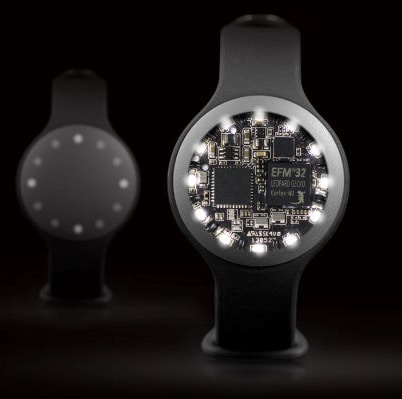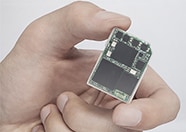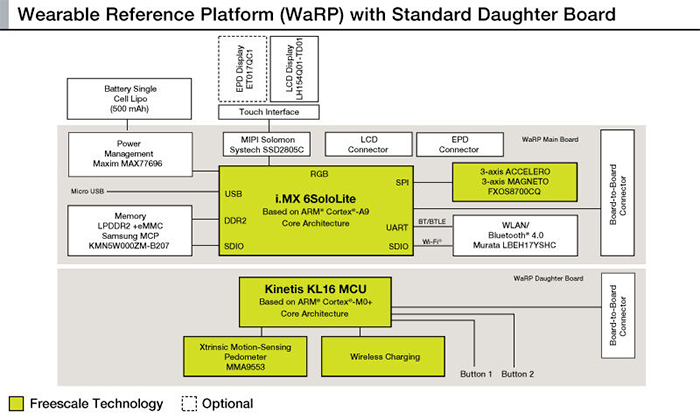Chips, Software and Platforms Converge for Wearable Design
By Steve Evanczuk, Mouser Electronics
Featured Products
Featured Suppliers
Resources
For healthcare providers, accurate diagnosis and treatment depends on a clear picture of an individual's health. Yet, healthcare providers rely on tests administered in physicians' offices, clinics, or hospitals that offer, at best, a static snapshot of an individual's ever-changing health dynamics. For individuals themselves, the need to go to an office or even deal with at-home medical equipment becomes disruptive and too often translates into noncompliance with health treatment plans.
The ability to review health data remotely through wearables promises measurable improvements in healthcare. According to the international Groupe Speciale Mobile Association (GSMA), a study of patients in the U.S. with chronic heart failure found that remotely monitored patients had fewer and shorter hospital stays than a control group, while a separate study noted that remote monitoring of patients with chronic heart failure could reduce re-hospitalizations by 72%. Like the GSMA, the Continua Health Alliance— a nonprofit industry organization of healthcare and technology companies— sees remote monitoring, or telehealth, as a key enabler for healthcare solutions needed to address skyrocketing spending on chronic disease already surpassing $500 billion/yr.
Wearable electronics can directly address these concerns, providing individuals and their healthcare providers with a clearer picture of health trends than available in the past. Rather than occasional snapshots of vital statistics taken in physicians' offices or hospitals, wearable health and wellness products offer a long-term view of an individual's physical condition. In fact, more advanced wearables will even provide instant response to health events or allow physicians to perform remote diagnostics and limited treatment.
Next-generation wearables
While fitness monitors have for years helped individuals track their heart rates around the clock, a new wave of more sophisticated wearables is looking to offer continuous updates of important diagnostic data. For example, iHealth Lab's ambulatory blood pressure monitor, wireless ambulatory ECG, and wearable pulse oximeter all combine wearable sensor systems that transmit data wirelessly to smartphones using Bluetooth. The ambulatory blood pressure monitor is designed to be worn inside a vest to provide 24-hour monitoring without changing a user's normal daily routine. The ECG device's electrodes and monitor are combined in a lightweight unit that attaches directly to the user's chest and can be worn under clothing, pushing data to the cloud for access by healthcare providers. Similarly, the pulse oximeter uses a fingertip sensor attached to a comfortable wristband, enabling oxygen saturation (SpO2) measurements 24 hours/day.
For their part, fitness trackers are shrinking in size, allowing users to wear them continuously, comfortably and inconspicuously. Next-generation fitness wearables such as the Garmin Vivofit, LG Lifeband Touch, and Sony Core are becoming more powerful, providing more data to more sophisticated apps able to offer better guidance on health and fitness.
Embedded sensors
Behind the rapid emergence of this new generation of wearables for wellness lie dramatic advances across a broad swath of technologies including sensors, ultra low power processors, wireless communications, flexible electronics and packaging. In fact, one of the key breakthroughs in the past few years has been the ability of manufacturers to weave sensor arrays into clothing, enabling development of diagnostic instruments that can be worn comfortably and unobtrusively.
For example, AiQ Smart Clothing embeds tiny stainless steel threads into fabric, providing a conductive mesh for embedded sensors able to monitor skin temperature and moisture as well as bioelectric measurements including electrocardiograms, electroencephalograms, and electromyograms, among others. Embedded unobtrusively in clinical garb such as patient gowns and blankets, this sensor array could noninvasively and continuously provide healthcare providers with an ongoing source of vital statistics.
Looking to reduce misdiagnosis in current screening procedures, First Warning Systems is using its own embedded sensor technology in its smart bra, designed to deliver non-radiogenic, noninvasive diagnostic data while being worn like any other bra. The company's smart bra embeds multiple sensors to collect data for predictive analysis by software that can actually alert physicians to possible abnormalities. Confirmed in clinical trials, First Warning Systems' technology monitors tissue changes that occur before tumors appear, offering an affordable early warning that helps make current screening practices more effective.
Treatment wearables
While enabling more sophisticated healthcare monitoring, wearables are gaining traction in treatment as well. For example, Thimble Bioelectronics is developing a small patch designed to offer mobile treatment for localized pain using transcutaneous electrical nerve stimulation (TENS) and electromyostimulation (EMS). TENS/EMS devices have tethered individuals to at-home equipment or equipment installed in physical therapists' treatment rooms. By providing the ability to gain long term, immediate treatment, a mobile patch offers the opportunity for extended relief from chronic pain
Insulet's OmniPod provides a wearable insulin delivery system in tandem with its Personal Diabetes Manager (PDM). The PDM combines a built-in blood glucose with wireless control of insulin injections administered by the small wearable insulin-delivery pod. Unlike conventional insulin injection systems, the waterproof OmniPod can be worn continuously— even while swimming and showering— without risking noncompliance or compromising an active lifestyle.
Creating a wearable product for medical, health and fitness applications presents new and unique design challenges. Engineers must combine advanced sensor systems, low-power embedded systems, and wireless communications into the smallest possible biocompatible packages. At the same time, wearables like wristbands or others likely to be visible must offer the form and fit of an attractive fashion accessory— while still providing extended running time between infrequent charges.
Ultra-low-power MCUs
For designers, the challenge becomes one of addressing the conflicting requirements of power and performance. As a result, highly integrated ultra-low-power MCUs typically lie at the heart of wearable designs. For example, Insulet based its OmniPod on Freescale Semiconductor's ultra-low-power S08 core architecture. These highly integrated MCUs combine on-chip RAM, flash, timers, ADCs and multiple interface options while providing multiple low-power modes featuring only 20 nA in power-down mode. With the MCU's very low power requirements, Insulet can remain confident that energy from the OmniPod's two AA batteries remains largely reserved for running the relatively power-hungry insulin pump.
For its Shine wearable wireless activity monitor, Misfit faced even greater power constraints. Misfit decided that requiring users to frequently recharge the Shine would interfere with its role as a continuously worn monitor. Consequently, Misfit powers its Shine activity monitor from a user-replaceable CR2032 Li-ion battery expected to provide at least four months of power for a feature-rich wireless application.
With this limited power budget, the Shine must process data from its 3-axis accelerometer using a series of sophisticated algorithms while driving an LED-based user interface and communicating wirelessly with the Shine app on smartphones. In this case, Misfit designed the Shine around the Leopard Gecko MCU - Silicon Laboratories ultra-low-power implementation of the ARM Cortex-M3 core (Figure 2). Features like the Gecko's low-energy sensor interface (LESENSE) and peripheral reflex system (PRS) help minimize power by allowing the MCU core to sleep while still collecting sensor data with LESENSE and allowing autonomous peripheral operations with PRS.

Figure 2: Powered by a user-replaceable CR2032 Li-ion battery, the Misfit Shine activity monitor is based on an ultra-low-power ARM Cortex-M3-core based MCU from Silicon Laboratories.
Intel designed its Quark MCU specifically to target wearable and similar deeply embedded applications where low power and small footprint are more critical than raw performance. The initial Quark device, the X1000, integrates a 400MHz 32-bit core with 512KB SRAM, a DDR3 memory controller and multiple connectivity options. Recognizing the growing need for security in wearable applications, the X1000 includes an on-chip boot ROM that provides a hardware root of trust used in authentication.
With its Edison development board, Intel provides wearable designers with a very small (SD card form) platform that combines a 400MHz Quark with two cores, LPDDR2 and NAND flash storage and both Wi-Fi and Bluetooth Low Energy (BLE) connectivity (Figure 3).

Figure 3: The SD-card-size Intel Edison development board features a two-core Quark with on-board memory and both Wi-Fi and Bluetooth Low Energy.
Reference designs
As more effective electronic components and packaging methods emerge, designers nevertheless face the considerable task of fashioning hardware and software components into practical wearable system designs. To help designers cope with the engineering challenges associated with wearables, manufacturers are offering reference designs, design kits and development frameworks. For example, the wearables reference platform (WaRP) is intended as a comprehensive open source, scalable solution for wearable design (Figure 4). WaRP combines the Freescale i.MX 6SoloLite ARM Cortex-A9 application processor, Xtrinsic MMA955xL Intelligent Motion-Sensing Platform, and Freescale FXOS8700CQ 6-Axis digital sensor with Kynetics software and Revolution Robotics hardware.

Figure 4: The Wearable Reference Platform (WaRP) combines a main board (top) with daughter board to offer complete hardware complement for a wearable design.
Texas Instruments offers its own Chronos Personal Area Network (PAN) and sensor node reference design based on an MSP430 MCU with integrated sub-GHz wireless transceiver. Offered in a sports watch format, the Chronos platform can be paired wirelessly with heart-rate monitors, pressure sensors, and other measurement units.
Movea partnered with TI and Xm-Squared to offer its G-Series wearable wristband reference design designed to monitor a wide range of health characteristics including activity, posture and sleep as well as movement speed and cadence. The reference design combines Movea's Motionsport embedded library and a wristband design from Xm-Squared with Texas Instruments' low-power CC2541 SoC, which provides both Bluetooth Low Energy and proprietary 2.4-GHz wireless communications. For medical applications, one of the reference design's distinguishing features is its support for sleep analysis able to deliver results close to polysomnography methods used in hospital sleep studies.
Conclusion
Wearables promise to address ongoing concerns in the healthcare industry about the quality and immediacy of vital statistics. By providing ready access to the results of long-term monitoring, wearable technologies can deliver data that healthcare providers need to diagnosis health problems more quickly and accurately — and begin to address skyrocketing costs for treatment of chronic disease and pain. With the continued emergence of more advanced sensors, ultra-low-power MCUs, flexible electronics and packaging, wearables are finding application in medical, fitness and health arenas once the sole domain of expensive hospital equipment or at-home units. For developers, a growing list of reference designs and design kits offer a ready starting point for venturing into wearable products.